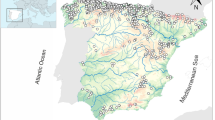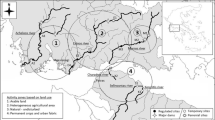Abstract
We examined how community composition of benthic invertebrates was related to current velocities and other environmental variables within the Sacramento River in California, USA. Invertebrates were collected in 1998 and 1999 from 10 sites over a gradient of 187 river kilometers. Canonical correspondence analysis revealed that current velocity was the most important variable explaining community composition. Other predicator variables that influenced community composition included periphyton biomass, altitude, and disturbance. Because of the importance of velocity in structuring benthic communities in this system, alterations of flow caused by changes in river regulation structures should be carefully considered.
Similar content being viewed by others
References
Armitage, P. D., 1984. Environmental changes induced by stream regulation and their effect on lotic macroinvertebrate communities. In Lillehammer, A. & S. J. Saltveit, (eds), Regulated Rivers. University Press, Oslo, Norway.
Armitage, P. D., R. J. M. Gunn, M. T. Furse, J. F. Wright & D. Moss, 1987. The use of prediction to assess macroinvertebrate response to river regulation. Hydrobiologia 144: 25–32.
Biggs, B. J. F., 1995. The contribution of flood disturbance, catchment geology and land use to the habitat template of periphyton in stream ecosystems. Freshwater Biology 33: 419–438.
Bowlby, J. N. & J. C. Roff, 1986. Trout biomass and habitat relationships in southern Ontario streams. Transactions of the American Fisheries Society 115(4): 503–514.
Brittain, J. E. & T. J. Eikeland, 1988. Invertebrate drift: a review. Hydrobiologia 166: 77–93.
Castleberry, D. T., J. J. Cech Jr., D. C. Erman, D. Hankin, M. Healey, G. M. Kondolf, M. Mangel, M. Mohr, P. B. Moyle, J. Nielsen, T. P. Speed & J. G. Williams, 1996. Uncertainty and instream flow Standards. Fisheries 21(8): 20–21.
Charpentier, B. & A. Morin, 1994. Effect of current velocity on ingestion rates of blackfly larvae. Can. J. Fish. aquat. Sci. 51: 1615–1619.
Cortes, R. M. V., M. T. Ferreira, S. V. Oliveira & D. Oliveira, 2002. Macroinvertebrate community structure in a regulated river segment with different flow conditions. River Research and Applications 18: 367–382.
Doisy, K. E. & C. F. Rabeni, 2001. Flow conditions, benthic food resources, and invertebrate community composition in a low-gradient stream in Missouri. J.n. am. Benthol. Soc. 20(1): 17–32.
Eaton, A. D., L. S. Clesceri & A. E. Greenburg (eds), 1995. Standard methods for the examination of water and wastewater. Baltimore, Maryland, American Public Health Association, United Book Press, Inc.
Edington, J. M., 1968. Habitat preferences in net-spinning caddis larvae with special reference to the influence of water velocity. Journal of Animal Ecology 37: 675–692.
Ellis, R. J. & H. Gowing, 1957. Relationship between food supply and condition of wild brown trout, Salmo trutta Linnaeus, in a Michigan stream. Limnology and Oceanography 11(4): 299–308.
Fuller, R. L. & K. W. Stewart, 1979. Stonefly (Plecoptera) food habits and prey preferences in the Dolores River, Colorado. The American Midland Naturalist 101(1): 170–181.
Griffith, M. B. & S. A. Perry, 1993. The distribution of macroinvertebrates in the hyporheic zone of two small Appalachian headwater streams. Arch. Hydrobiol. 126(3): 373–384.
Gore, J. A., 1989. Models for predicting benthic macroinvertebrate habitat suitability under regulated flows. In Gore, J. A. & G. E. Petts (eds), Alternatives in Regulated River Management, CRC Press, Inc., Boca Raton, Florida: 253–265.
Growns, I. O. & J. A. Davis, 1994. Longitudinal changes in near-bed flows and macroinvertebrate communities in a Western Australian stream. J. n. am. Benthol. Soc. 13(4): 417–438.
Hinton, D. E., 1998. Multiple stressors in the Sacramento River watershed. In Braunbeck, T., D. E. Hinton & B. Streit (eds), Fish Ecotoxicology, Birkhaeuser Verl., Basel: 303–317.
Jowett, I. G. & J. Richardson, 1990. Microhabitat preferences of benthic invertebrates in a New Zealand river and the development of in-stream flow-habitat models for Deleatidium spp. New Zealand Journal of Marine and Freshwater Research 24: 19–30.
Lancaster, J. & A. G. Hildrew, 1993. Characterizing in-stream flow refugia. Can. J. Fish. Aquat. Sci. 50: 1663–1675.
LaVoie, W. J. & W. A. Hubert, 1996. Use of three types of streammargin habitat by age-0 brown trout late in the growing season. Hydrobiologia 317: 89–95.
Merz, J. E. & C. D. Vanicek, 1996. Comparative feeding habits of juvenile chinook salmon, steelhead, and Sacramento squawfish in the lower American River, California. California Fish and Game 82(4): 149–159.
Minshall, G. W. & J. N. Minshall, 1977. Microdistribution of benthic invertebrates in a Rocky Mountain (U.S.A.) stream. Hydrobiologia 55(3): 231–249.
Moog, O., 1993. Quantification of daily peak hydropower effects on aquatic fauna and management to minimize environmental impacts. Reg. River Res. and Manage. 8: 5–14.
Morgan, R. P. R. E. Jacobson, S. B. Weisberg, L. A. McDowell & H. T. Wilson, 1991. Effects of flow alteration to benthic macroinvertebrate communities below the Brighton hydroelectric dam. J. Freshwater Ecology 6(4): 419–429.
Muir, W. D. & T. C. Coley, 1996. Diet of yearling chinook salmon and feeding success during downstream migration in the Snake and Columbia Rivers. Northwest Science 70(4): 298–305.
Nelson, S. M. & R. A. Roline, 1995. Aquatic macroinvertebrate communities and probable impacts of various discharges: Upper Arkansas River. Technical Memorandum No. 8220-95-4. Technical Service Center, Bureau of Reclamation, Denver, Colorado.
Petts, G. E., 1984. Impounded Rivers: Perspectives for Ecological Management. John Wiley & Sons, New York.
Pfankuch, D. J., 1975. Stream reach inventory and channel stability evaluation. US Department of Agriculture Forest Service, Region 1, Missoula, Montana.
Porter, S. D., T. F. Cuffney, M. E. Gurtz & M. R. Meador, 1993. Methods for collecting algal samples as part of the National Water-Quality Assessment Program: US Geological Survey Open-File Report 93-409, 39 pp.
Quinn, J. M. & C. W. Hickey, 1990. Magnitude of effects of substrate particle size, recent flooding, and catchment development on benthic invertebrates in 88 New Zealand rivers. New Zealand Journal of Marine and Freshwater Research 24: 411–427.
Rader, R. B. & J. V. Ward, 1988. Influence of regulation on environmental conditions and the macroinvertebrate community in the upper Colorado River. Regulated Rivers: Research and Management 2: 597–618.
Rice, S. P., M. T. Greenwood & C. B. Joyce, 2001. Tributaries, sediment sources, and the longitudinal organization of macroinvertebrate fauna along river systems. Can. J. Fish. Aquat. Sci. 58: 824–840.
Statzner, B., J. A. Gore & V. H. Resh, 1988. Hydraulic stream ecology: observed patterns and potential applications. J.n. am. Benthol. Soc. 7(4): 307–360.
Townsend, C. R., M. R. Scarsbrook & S. Dolédec, 1997. Quantifying disturbance in streams: alternative measures of disturbance in relation to macroinvertebrate species traits and species richness. J.n. am. Benthol. Soc. 16(3): 531–544.
(U.S.D.I.) United States Department of the Interior, 1999. Shasta Dam and Reservoir Enlargement: Appraisal Assessment of the potential for Enlarging Shasta Dam and Reservoir. Bureau of Reclamation.
Vinson, M. R., 2001. Long-term dynamics of an invertebrate assemblage downstream from a large dam. Ecological Applications 11(3): 711–730.
Ward, J. V., 1976. Effect of flow patterns below large dams on stream benthos: a review. In Osborn, J. R. & C. H. Allman, (eds), Instream Flow Needs Symposium, Vol. II. American Fisheries Society, Bethesda, Maryland.
Ward, J. V. & J. A. Stanford, 1979. Ecological factors controlling stream zoobenthos with emphasis on thermal modification of regulated streams. In Ward, J. V. & J. A. Stanford, (eds), The Ecology of Regulated Streams. Plenum Press, New York: 35–55.
Winget, R. N., 1984. Brachycentrus americanus and B. occidentalis (Trichoptera) in a regulated stream. Journal of Freshwater Ecology 2(4): 373–381.
Author information
Authors and Affiliations
Rights and permissions
About this article
Cite this article
Nelson, S.M., Lieberman, D.M. The influence of flow and other environmental factors on benthic invertebrates in the Sacramento River, U.S.A.. Hydrobiologia 489, 117–129 (2002). https://doi.org/10.1023/A:1023268417851
Issue Date:
DOI: https://doi.org/10.1023/A:1023268417851




